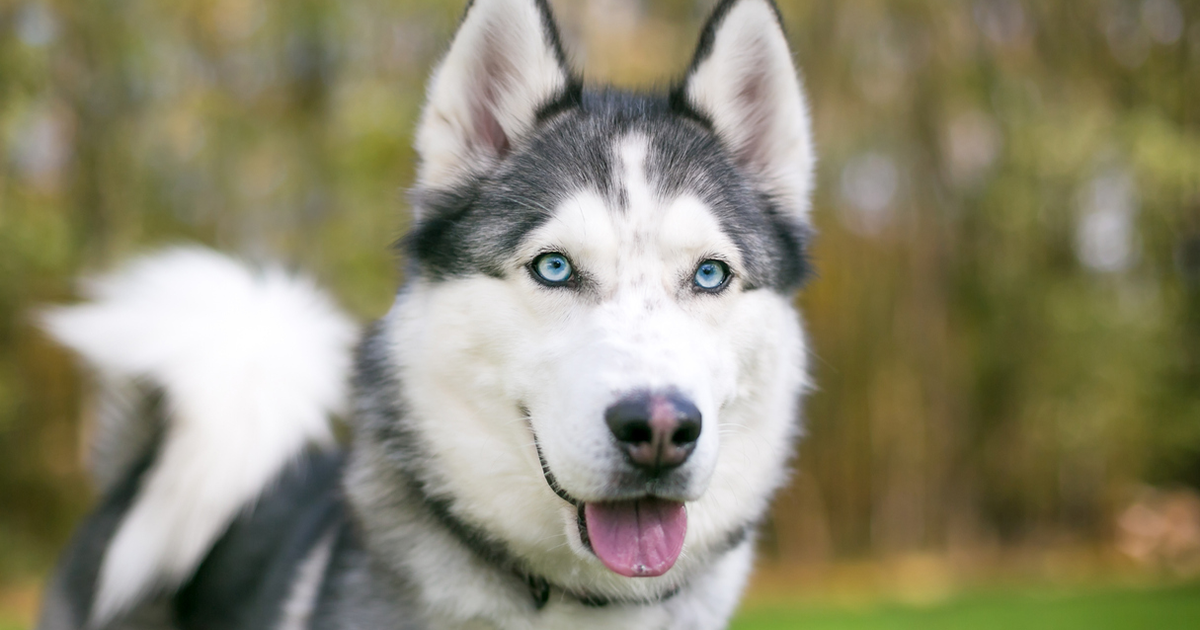I could not pretend to advocate for pit bulls with my Flower Power project, if I didn’t meet the controversial Pit Bulls too. Here is one of them.
The first time I heard about Mickey, my eyes caught the headline of an online article: “Pit Bull gets life in prison”. Somewhere, in the U.S., a dog was sitting in a jail. Apparently, he had attacked a toddler, disfiguring the child, and was later sentenced to life in jail without possibility of parole. A quick Google search revealed a website with a live-feed webcam into Mickey’s jail cell.
https://www.youtube.com/watch?v=DDAq_uuXsSw
There he was. A beautiful white American Bulldog, alone, behind bars. The fact that there was no sound on the video only accentuated the feeling of loneliness. Sometimes, Mickey would get up, wag his tail to invisible people passing by his cell, only to go back to his sitting position, often head down. I was heartbroken and angry, and for the next few days, I watched Mickey and I cried. I watched him for hours. He wouldn’t know I was there, but I needed to know that he was not alone. I see dogs in shelters all the time, and really, it’s not that different: a dog sitting in a kennel, behind bars, because of the actions of their owners. Except that for shelter dogs, there is hope of a happy ending, a family, a loving home at last. With Mickey, there would be none of that since he was never to be adopted out. I was looking at a ghost, a dog who would never walk outside again, never sleep on a sofa or run free in a garden. At least that’s what I thought, and what the articles I had read lead me to believe. I made up my mind: I would meet this dog, at all cost. And maybe, even crown him with flowers if I was allowed, for my Flower Power project.
Something hit me as I watched his webcam feed: in Mickey’s jail cell, his name was written on his food bowl. Toys were dispersed on the floor. He had a cute doghouse, a comfy bed. Greeting cards sometimes covered the bars of his cell. It dawned on me: not only was Mickey not alone but he actually had a whole lot of people caring for him, including a large following on Facebook. Mickey was loved.
A few months later, I traveled to Arizona for my Pit Bull Flower Power project. I reached out to the MASH Unit in Phoenix, the place hosting Mickey, an old jail reconverted into a shelter. They informed me that Mickey had been moved to a medical facility for health reasons in June 2015. If I wanted to meet Mickey, I would have to go through his lawyer, John A. Schill. I reached out to John and we agreed to meet. We also had a photoshoot and I was able to crown Mickey.
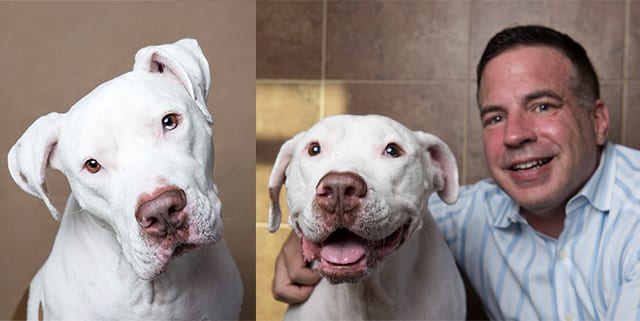

Mickey and John A. Schill
John is a lawyer based in Phoenix, who takes on lots of dog-related cases, and he is the proud dad of pit bull rescues. More than a lawyer, John has become the closest Mickey will ever be to getting a family of his own: someone who cares deeply about him, visiting him at least once a week in his boarding facility, covering his vet expenses, sharing his story and making sure Mickey’s needs will always be covered.
In November 2015, I sat with John and he explained the circumstances that led Mickey to be locked up for the rest of his life: Mickey comes from what could be described as a bad neighborhood. He lived chained on one side of a 2-acre yard, surrounded by 4 or 5 houses. When the accident happened, Mickey must have weighted about 15 to 20lbs less than he should have. He had no shelter and was living off scraps and rawhide bones. Since no police investigation was conducted after the accident, this is what Mickey’s legal team was able to determine through an investigation of their own: in February 2014, two small children who were supposed to be supervised by an adult were out with Mickey. He was chewing on a bone. The adult took a phone call and left the children unsupervised. A 4-year-old boy ran over to Mickey and took his bone. Mickey growled once, the child yanked the bone back. Mickey bit the boy in the face.
Did Mickey intentionally bite? Or did he mean to grab the bone back, grabbing by accident the child’s face at the same time? We will never know, but unfortunately during the tragic event the child was severely injured, Mickey biting right under the orbital. The adults rushed the child to an emergency care. He will need multiple reconstructive surgeries. At the time this article was written, he’d already gone through three surgeries and was in recovery. Hours after the accident, the adults came back for Mickey and brought him to a local police station, asking that he’d be euthanized. Soon, the story was making headlines in the media, not just in Phoenix but nationwide. Mickey was labeled “a Pit Bull”, “evil” and called “the devil dog” by some media. Another vicious Pit Bull-type dog, responsible for a horrific accident.
Vicious? Responsible? Mickey became a symbol, dividing people on the Pit Bull issue once more (even though, technically, he is an American Bulldog, one of the breeds often mislabeled “pit”). To this day, the people involved in Mickey’s case still get “hate mail”, as well as a few death threats, which were investigated by the Police. Mickey’s case also rallied people who believed he was a victim, just like the child, and begged for leniency, a petition reaching nearly 70,000 signatures. They believed Mickey’s owner should be held responsible, for placing Mickey in an impossible situation, and setting him up for something tragic to happen.
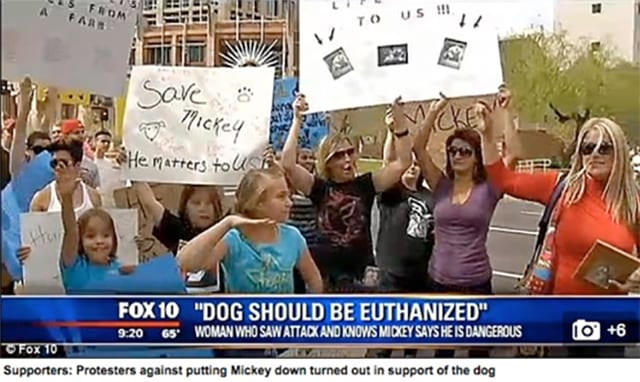

The Lexus Project, an organization that provides legal aid to dogs, reached out to John A. Schill and asked him to represent Mickey. “They told me there had been this horrible accident in Phoenix involving a Pit Bull, that they didn’t think I could win the case, that it would probably break my heart, but wanted to see if I’d give it a try.” John agreed. A “Vicious Dog Action” was brought up against Mickey, but the judge declared that John could only represent Mickey after she had ruled on whether or not he was vicious.
The judge determined that Mickey was vicious, and the death penalty was on the table. At sentencing, John managed to convince her not to kill Mickey, if proper sanctuary could be found for him, for the rest of his life. That’s when Sheriff Joe Arpaio from the Maricopa county offered to take him into his MASH Unit, a former jail turned shelter (which I visited as well, see my other story here). John decided with the MASH Unit that they would be the best suited for Mickey, for the time being.
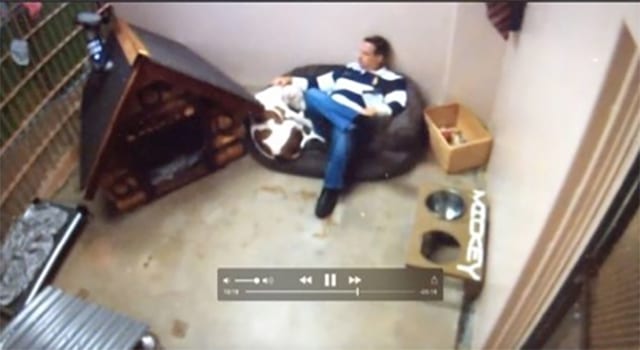

Mickey having a consultation with his lawyer, John
Mickey stayed a little over a year at the MASH Unit. There, his kennel was a reconverted jail cell, and that’s where the webcam was placed, allowing his thousands of fans to follow (sometimes, more like “monitor”) his daily activities. I asked Officer Keeney from the MASH Unit to tell me more about his encounter with Mickey, and the work they did together for the year he spent there. Officer Keeney is also a dog trainer, so he was the one to evaluate Mickey upon arrival at the shelter, and the one to train and rehabilitate him over the next few months. “I met Mickey at the door when John walked him in,” Officer Keeney told me. “We went straight to my personal evaluation. There is a look you can see in a dog’s eyes when it’s apprehensive, fearful, or aggressive; Mickey showed none of these signs. He played around with me and I began a few temperament tests on him. Touching his mouth, grabbing at his paws, rolling him over on his back. He was a happy dog, though very malnourished.”
At first, the shelter staff were a little worried about the kind of dog he might be. That soon changed when they discovered the happy dog he was, and got their share of slobbery kisses each time they saw him.
So did Mickey need rehabilitation? Was he a “vicious dog”, as he’d been legally labeled? Officer Keeney recalls the year they spent together, working on leash manners and dropping food or toys, not rushing through doors, dominance training around other dogs, etc. “Mickey is one of my favorite dogs that have ever come to the Unit and one of the best dogs we’ve ever had,” Keeney told me. “I miss him every time he is brought up in conversation. He was about as dangerous as a fruit fly, not a bad bone in his body. I could even put my whole hand in his mouth and take food out of it, while he was eating! It’s amazing how a dog will act when he is actually being well cared for! I full heartedly believe Mickey was a victim of animal neglect/abuse and the victim of just really bad circumstances.”
In June 2015, Mickey was diagnosed with skin cancer, having spent the first years of his life tied outside, left in the harsh sun of Arizona with no shelter. He was moved to an undisclosed medical facility to undergo treatment. No webcam, this time, and the location of the facility will not be revealed, so that Mickey and the people that care for him can be left in peace. I was told by John, his lawyer, that Mickey gets about 6 to 7 interactions with humans per day. His room is always full of toys – something I witnessed when I visited him! All in all, Mickey is spoiled and, according to the people in charge of his care, in a much better place than he was with his previous owner.
When I met him, he seemed a little under the weather and was diagnosed shortly after with hip dysplasia, which he is now being treated for with medication. His lawyer John is the one covering his medical expenses. I am hosting a print fundraiser to help Mickey and John, please consider purchasing a print! 100% of the proceeds will go to Mickey’s vet account.
Throughout this experience of meeting Mickey, his lawyer/caretaker John, his trainer Officer Keeney, and reading about his case, many questions haunted me, some of which will remain unanswered: Are our judges and legal system equipped to determine whether or not a dog is really vicious? Had Mickey been from a different breed group, not a “Pit Bull-type dog”, would the story have been so controversial and the discussions heated? Would the outcome have been the same for Mickey? And last, but not least: is it fair to keep a dog locked up for the rest of his life? Even if, all in all, his quality of life is much better than what it was when he was tied outside and neglected?
I asked that last question to John. “As long as Mickey has a good quality of life, euthanasia is off the table. Mickey has been the most difficult case I have taken,” John told me. And when I asked him why, the lawyer’s voice choked up and his eyes watered:
“Because he can’t get out. It’s hard to see him and to know that he will never get out. I would love to take Mickey home but I can’t. He has never shown any propensity to bite. I feel really bad for him because I just don’t see it in him that he attacked the kid. It was purely an accident. And unfortunately now he has been labeled a vicious dog. I choose to care about Mickey. I feel bad for his situation and what’s happened to him, and to the boy. But if I don’t care for Mickey, who will? If I did not stand up for Mickey, he would be dead. That’s the bottom line. He is my responsibility.”
And that’s probably the lesson here, that all of us carry a responsibility toward dogs. Some call them “the voiceless”. Thanks to John and thousands of people around the country, Mickey had a voice. And despite the tragedy of his case, what benefit is there to place the blame on the dog? Dogs don’t understand our technicalities and judicial system. Dogs understand training, compassion, rules we teach them. Dogs understand kind hands that care for them and feed them.
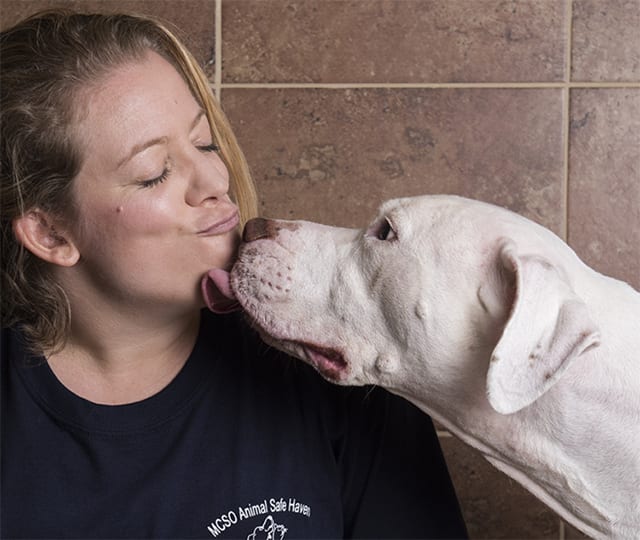

This post was republished from Sophie Gamand’s website.




